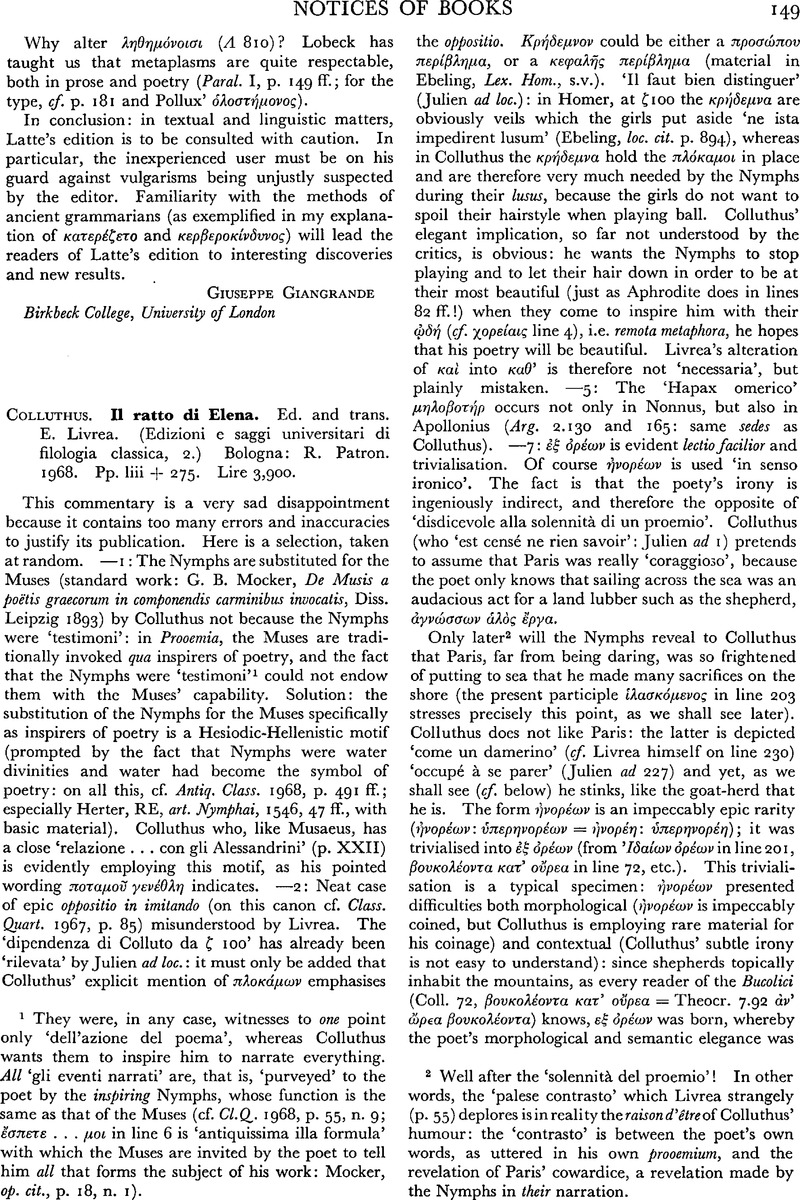Article contents
Colluthus. Il ratto di Elena. Ed. and trans. E. Livrea. (Edizioni e saggi universitari di filologia classica, 2.) Bologna: R. Patron. 1968. Pp. liii + 275. Lire 3,900.
Published online by Cambridge University Press: 23 December 2013
Abstract

- Type
- Notices of Books
- Information
- Copyright
- Copyright © The Society for the Promotion of Hellenic Studies 1969
References
1 They were, in any case, witnesses to one point only ‘dell'azione del poema’, whereas Colluthus wants them to inspire him to narrate everything. All ‘gli eventi narrati’ are, that is, ‘purveyed’ to the poet by the inspiring Nymphs, whose function is the same as that of the Muses (cf. Cl.Q. 1968, p. 55, n. 9; ἔσπετε … μοι in line 6 is ‘antiquissima ilia formula’ with which the Muses are invited by the poet to tell him all that forms the subject of his work: Mocker, op. cit., p. 18, n. 1).
2 Well after the ‘solennità del proemio’! In other words, the ‘palese contrasto’ which Livrea strangely (p. 55) deplores is in reality the raison d'être of Colluthus' humour: the ‘contrasto’ is between the poet's own words, as uttered in his own prooemium, and the revelation of Paris' cowardice, a revelation made by the Nymphs in their narration.
3 The technique is exactly the same in Theocritus and in Colluthus: cf. Gow ad Theocr. 25.1: ‘the opening closely resembles that of Od. 9, but many books in both Homeric poems are connected by δέ with what precedes’. Precisely! Both Theocritus and Colluthus imply that their epyllia are truncated episodes, to be mentally connected by the reader with the antefatti. In other words, Gow and Weinberger are wrong in criticising Theocritus' and Colluthus' respective ouvertures.
4 In other words: Colluthus' ‘commissure des paupières’ (Tournier) makes perfect sense, in the light of Nonnus' passage: Paris had to judge which of the three goddesses had the most almond-shaped eyes.
5 The motif is not new: for a glass which acquired the scent from a μίτρη cf. Cl. Rev. 1967, p. 22.
6 Weinberger was inconsistent because of his unfamiliarity with ‘alexandrinische’ Epic (art. cit. p. 155): he recognizes that Colluthus has cases of masculine ‘Motion’ (art. cit. p. 129), and yet he states that περόνην θυόεντα is ‘unbedingt zu verwerfen’. In reality, just as certain cases of masculine ‘Motion’ in Colluthus are modelled ‘nach homerischem Vorgang’ (art. cit. p. 129), so the ‘Motion’ περόνην θνόεντα in line 82 is clearly modelled after Hellenistic ‘Vorgang’ (cf. Klauser and Volkmann, loc. cit.), as is the case with ζοφόεντα πορείην in Orph. Hymn. 78.4.
7 Not, of course, ‘par-dessus’ (Tournier ad loc.)!
8 In both cases (Coll. 123 δειμαίνων δὲ κτλ. Mus. 331 νείκεαε δὲ κτλ.) the new scene starts with the beginning of a fresh line.
9 Only the poet living in town produces artistically elaborate poetry, πολλὰ μογήσας, as opposed to the uncouth rustics, according to Philitas (Antiq. Class., loc. cit.). Note πολλὰ μογήσας = Colluthus' πολλὰ καμοῦσα.
10 Material, not yet fully studied, in Ameis-Hentze, Anhang to Od. 18.265 who approve of Savelsberg (Savelsberg contradicted by Kühner-Blass II, p. 215, Anm. 3).
11 Typical piece of humorous ‘arte allusiva’, for the benefit of ancient ‘lettori colti’: in Apollonius, Aphrodite addresses τοῖα μειδιόωσα the other goddesses, and her smile is suitable to the tone in which ‘de vraies grandes dames’ converse (cf. Mooney ad loc.); in Colluthus, Aphrodite addresses τοῖα μειδιόωσα … a stinking shepherd: her ‘atteggiamento suppli chevole’ is certainly ‘indegno’ of a goddess (cf. Livrea, p. 136), but there is evidently no limit to what a lady will do in order to ingratiate herself to the judge in a beauty competition. Μηλοβοτῆρα, skilfully placed by Colluthus after the Apollonian formula, aptly emphasizes the grotesque contrast between the Apollonian scene and the scene he has created. Such technique of implied contrast is typically Hellenistic, as I have shown in Antiq. Class., art. cit., pp. 531 ff. Colluthus' humour, in its pointed allusion to Apollonius, is, alas, lost upon Livrea. When Aphrodite, in Colluthus, addresses her rival goddesses, her manner of a ‘vraie grande dame’ disappears: her smile, which she has reserved for a stinking shepherd, is replaced by … insults: ![]() 189. This is really Hellenistic humour at its best.
189. This is really Hellenistic humour at its best.
12 ‘More Doriensium’: a study of ‘Dorisms’ in Epic, from Homer down to ‘i tardi epici’, would be interesting. Cf. e.g., Weinberger, art. cit. p. 128, n. 20, and e.g. Carm. Sib. 3.591 ed. Rzach.
13 That the Nonnian poets are firmly ‘in der Tradition der gelehrten alexandrinischen Dichtung’ (Gelzer, , Mus. Helv. 1968, p. 30Google Scholar) must never be forgotten.
14 Cf. e.g., Il. 2.159 θαλάσσης ≠ Ap. Rh. 4.1246 χθονός.
15 I should like to note, en passant, that Colluthus' skilful Sprachgebrauch serves to characterise felicitously women and children (cf. my notes on lines 158, 242 and 371): this type of characterisation is, as every specialist knows, typical of Hellenistic poetry.
- 2
- Cited by




